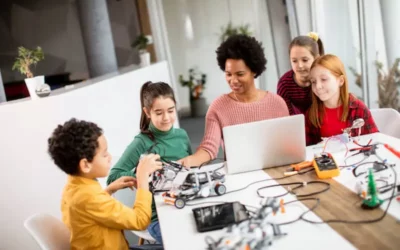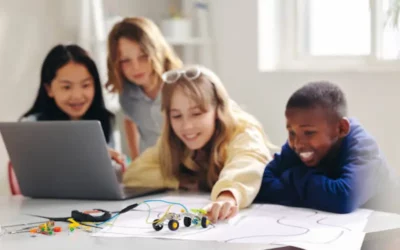Robot programming plays a pivotal role in today’s rapidly advancing world of automation and artificial intelligence. As we witness the increasing integration of robots in various industries, understanding the significance of robot programming becomes essential.
This discipline not only empowers machines to perform complex tasks with precision but also paves the way for innovative solutions that drive efficiency and productivity. In this brief exploration, we delve into the key aspects that make robot programming a fundamental component of the modern technological landscape.
Table of contents
Benefits of Learning Robot Programming
In today’s rapidly evolving world, technology plays a crucial role in shaping our lives and the way we interact with the world around us. As we embrace the era of automation and robotics, learning robot programming has become an increasingly valuable skill.

Advancing Technological Literacy: Preparing for the Future
Robot programming introduces individuals to the fundamentals of technology and automation. By understanding the inner workings of robots and how to program them, learners gain insights into the broader landscape of artificial intelligence, machine learning, and robotics. This knowledge empowers them to navigate a world that’s rapidly embracing automation and robotics in various sectors, such as manufacturing, healthcare, logistics, and even daily chores.
Enhancing Problem-Solving and Computational Thinking Skills
Robot programming is a challenging yet rewarding endeavor that demands creativity and problem-solving skills. To make a robot perform specific tasks, programmers must break down complex problems into smaller, manageable steps. This process sharpens their ability to think logically and algorithmically, a skill set that extends far beyond the realm of robotics.
Programming Languages for Robotics
Programming languages play a crucial role in the world of robotics, enabling developers to create intelligent and interactive machines. In this blog, we will explore some of the most popular programming languages used in robotics, with a focus on Python and C++. By understanding their strengths and weaknesses, you can make an informed decision on which language suits your robotics project best.

Python for Robotics:
Python has emerged as a favorite language for robotics kits for kids due to its simplicity and readability. With an extensive library ecosystem, such as NumPy, SciPy, and OpenCV, Python facilitates rapid development and experimentation.
C++ for Robotics:
For resource-intensive robotics applications that demand high performance, C++ shines as a top choice. Its direct memory management and low-level access to hardware give it an edge in real-time control and computation-heavy tasks.
Choosing the Right Language:
Selecting the right programming language for your robotics project depends on several factors. Consider the complexity of your project, the hardware you’re working with, and the real-time requirements. If you prioritize ease of development and prototyping, Python is a safe bet. On the other hand, if performance is paramount, C++ may be the best fit.
Sensors and Perception in Robot Programming
In the world of robotics, sensors play a pivotal role in enabling machines to perceive and interact with their environment. From autonomous vehicles to industrial robots, the ability to process sensory data efficiently can be the difference between success and failure.

Sensors in Robotics: Understanding Sensory Data
Sensors act as the eyes and ears of robots, providing them with vital information about their surroundings. They come in various types, such as cameras, lidars, ultrasonic sensors, and more, each catering to specific environmental cues.
Integrating Perception Algorithms: Image and Object Recognition
Perception algorithms are the backbone of robots’ cognitive abilities. Among them, image and object recognition are of utmost importance. Image recognition algorithms process visual data from cameras, allowing robots to identify and classify objects, people, or landmarks.
Robot Ethics and Safety Considerations
As robotics technology advances, our world is witnessing a growing presence of robots in various fields. While this technological leap brings numerous benefits, it also raises ethical concerns and safety considerations.

Ethical Concerns in Robotics:
As robots become more integrated into our lives, ethical considerations come to the forefront. One major concern is the potential impact on employment, as robots could replace human workers in certain industries.
Addressing Human-Robot Interaction:
To foster harmonious human-robot interaction, we need to emphasize transparency and clear communication. Users should be aware of when they are interacting with a robot to prevent unintended psychological consequences. Ensuring robots display distinct behaviors will help maintain a clear distinction between human interactions and robot interactions.
Ensuring Safe Robot Programming:
Safety is paramount when dealing with robots, particularly in shared workspaces. Implementing safety protocols during robot programming is vital to prevent accidents and injuries. These protocols may include obstacle detection and collision avoidance systems, speed and torque limits, and emergency shutdown mechanisms.
Future Trends in Robot Programming
In the rapidly evolving field of robotics classes for kids, technological advancements have played a pivotal role in reshaping industries and daily life. As we delve into the future, one crucial aspect that stands out is robot programming.

Artificial Intelligence (AI) and Machine Learning Integration
The future of robot programming lies in the seamless integration of artificial intelligence and machine learning. Robots equipped with AI capabilities can adapt to dynamic environments, learn from experiences, and optimize their actions.
Human-Robot Collaboration
Collaborative robots, or cobots, are revolutionizing the way humans and robots work together. Future trends in robot programming focus on developing safe and intuitive interfaces that allow humans to interact effortlessly with robots. T
Multi-robot Systems and Swarm Robotics
Robot programming is moving beyond individual units, embracing the potential of multi-robot systems and swarm robotics. These systems enable a group of robots to communicate, cooperate, and coordinate tasks, fostering efficiency and versatility.
Cloud Robotics and Connectivity
Cloud computing and high-speed connectivity will play a significant role in robot programming trends. By offloading heavy computation to the cloud, robots can access vast amounts of data and computational power, enabling faster learning and decision-making processes.
Low-Code and No-Code Robot Programming
To democratize robot programming, the future is likely to witness the rise of low-code and no-code development platforms.These user-friendly tools will allow non-experts to create and customize robot behaviors with intuitive interfaces and drag-and-drop functionalities. Exploring kids computer programming options can introduce young learners to these tools and encourage them to explore robotics and programming.
Conclusion
In conclusion, the empowerment of innovators and creators through robot programming is pivotal in shaping a transformative future. By providing individuals with the tools and knowledge to harness the potential of robotics for kids, we unlock endless possibilities for innovation and creativity.
As we embrace this technological revolution, we pave the way for a more connected, efficient, and sustainable world, where human potential knows no bounds. Together, we can forge a path toward a brighter tomorrow, where robot camps and humans collaborate harmoniously to build a better society.
Frequently Asked Questions
A1. No, prior programming experience is not always necessary. Many robot programming resources cater to beginners, providing step-by-step instructions for learning the basics.
A2. There are various online platforms like Coursera, Udemy, and YouTube offering courses and tutorials for robot programming, suitable for learners of different levels.
A3. Yes, robot programming is a promising career path with the growing demand for robotics camps for kids in various industries, such as manufacturing, healthcare, and automation.
A4. Yes, there are several age-appropriate robot programming tools and platforms designed specifically for kids and beginners, making it accessible and engaging for young learners.
A5. Robot programming plays a crucial role in advancing artificial intelligence by enabling robots to perform complex tasks, learn from their experiences, and adapt to different environments, ultimately enhancing AI capabilities.


 We are an army of educators and passionate learners from BrightChamps family, committed to providing free learning resources to kids, parents & students.
We are an army of educators and passionate learners from BrightChamps family, committed to providing free learning resources to kids, parents & students.














